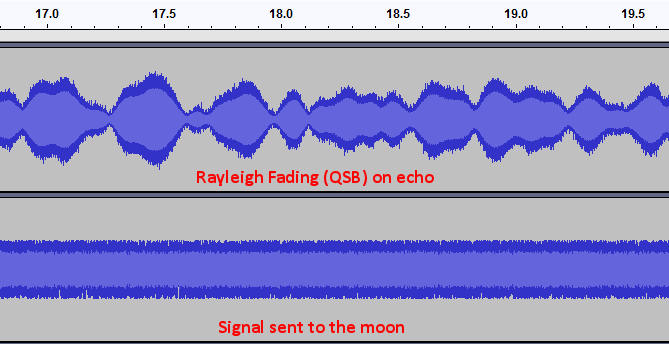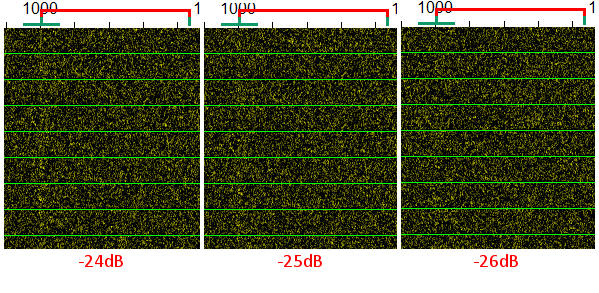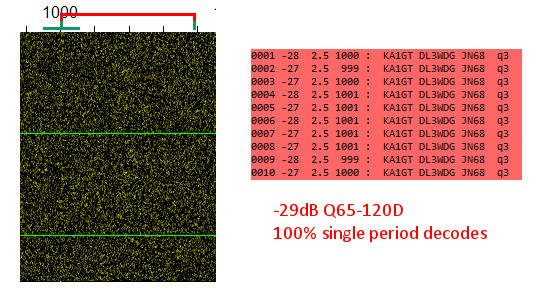Q65 - When to switch to a longer period
Note: This article uses examples of signals which are characteristic of 1296 EME. Thugh the general conclusions apply to all bands, the submodes simulated are those which would be used for signals with the Doppler spreading found on that band. Signal visibility estimates are for signals with 15Hz spreading. All numbers relate to WSJTX 2.4.0-rc1
Conclusion (for those who don't like reading): Averaging helps, but it's not a substitute to using a longer period mode. If it requires more than two periods to get an averaged decode, it's time to consider moving to the next longer period. You can't reach the sensitivity of one 300s long Q65-300 transmission decode by averaging ten 30 second Q65-30 transmissions decodes, even though they both take 300 seconds.
The Q65 mode for digital EME gives you a couple of options which will increase decode sensitivity for weaker signals. You can select from 30s, 60s, 120s or 300s transmision periods, with longer periods providing higher sensitivity. You can also average received signals, which also increases receive sensitivity. So what's the best mode to use? Do you use 30B and average signals, or do you use 60C and hope for a single period decode. If you need the average of two transmissions using 30B to get decodes and one on 60C, the QSOs will both take the same time, since each requires 60s of transmission before the receiving station get a decode.
Obviously statistics play a big part in this. When averaging decodes, it could take two periods, or it could take 3, or 4 - or just one. You don't know. If you've made 3 transmissions without a decode, do you "cut your losses" and switch to a longer period mode or do you try for a 4th period on the grounds that if you don't, you've "wasted" the first three attempt!
There are a lot of factors in play here. In addition, if you change, you both have to change and in the absence of feedback from the DX station in real time that's hard to coordinate.
It's Rayleigh Fading (QSO) on the lunar echo which makes all of this a statistical process. You can't predict which parts of any message can be recovered and decodes.

Example of Rayleigh Fading (QSO) on a lunar echo
An understanding of averaging in Q65 and how to use it might be useful at this point. Please see Q65 averaging at low signal levels for more details on averaging.
So are there any general rules you can use? The answer is, I think, yes. I ran a number of simulations at various signal levels using various modes. I assumed conditions that typically apply on 1296 EME, so the simulated signal has 15 Hz spreading and the modes were 30B, 60C, 120D and 300E, a typical set of choices for 1296 EME. I simulated signals ranging in strength from -25dB to -34dB. These are weak signals. The stronger ones are JUST visible on the waterfall display, the weaker one can't be seen at all. If spreading was much wider, none of them would be visible.
This leads to the first rule (at least for 1296). If both stations can see the other's sync tone trace, there's a very good chance that Q65-30B will work just fine with a single period decode, and if you don't get a single period decode, the odds are very high you will get a 2 period average decode. Even at -27dB (which is getting very hard to see) there's about a 50% change you will get either a one or two period decode using Q65-30B. This result in the same QSO duration as using Q65-60C.
If you wanted the best chance of making a QSO that you knew was going to be very difficult due to weak signals, stating with Q65-300E would make sense, but a QSO would take between 20 and 30 minutes (depending on the number of 73s exchanged) even if every transmission resulted in a single period decode. This is an unreasonably long time of a shorter period mode can be used. If you don't get a single period decode with Q65-300, you have to repeat the transmissions and hope that averaging will eventually help.
Below is a chart which shows the total number of decodes (single period +averaged) out of a total of 20 attempts for the modes 30B, 60C, 120D and 300E over an S/N 0f -24dB to -35dB. -24dB is weak. The sync trace is visible, but you have to look for it. Once you get to -28dB, the sync trace is pretty much invisible. It's important to remember that a q65-30 QSO will take at least 2.5 minutes, a Q65-60 QSO will take at least 5 minutes, a Q65-120 QSO will take at lest 10 minutes and a Q65-300 QSO will take at least 25 minutes. These times assume that every exchange results in a single period decode (no averaging).
The files used were all simulations using the Q65sim simulator which includes the effects of Rayleigh fading, Doppler broadening (15Hz in this case) and Doppler racking accuracy (perfect tracking assumed). Note there are only 20 samples at each mode/strength combination, so differences of 1 or 2 in the numbers are probably not significant and all the numbers (especially when <20 and some averaging is involved) would probably be slightly different if the test was run a second time on a separate set of files. The would also be different for different submodes or for different values of Doppler spreading, though the general tread of the numbers would be expected to be similat, even if their absolute values were different.

- Black numbers on a red background represent every signal decoded in a single period
- Black numbers on a orange or blue backdground are total decodes (out of 20), whether single period or averaged
- Green numbers on orange or blue background are the number of single period decodes
- Blue dots represent the approximate 50% decode level (for single period decodes)
- Grey indicates no decodes of any type after 20 tramsmissions
- Times (m) are minimum QSO time assuming all single period decodes and no repeats
So, for example, at -24dB, Q65-30B should pretty much give you a single period decode every time and would be the optimum (fastest QSO) mode to use at this signal strength. It's pretty weak. I'd say that maybe 95% of my contacts on 1296 over the last few years (using a 3m dish) are probably stronger than -24dB.
But the numbers are a little deceptive at first sight. They give the probability of a single signal decoding, and that's not a QSO. A QSO typically consists of 5 exchanges. It could be just 4 or it could be 6, depending on how may 73s are sent and if the QSO is a sked or starts with a CQ. But lets take 5 exchanges as a "standard" QSO. Lets look now at Q65-30B at -27dB. we see that there were 10 decodes out of 20 attempts, so you could say that there's a 50% chance of a decode for any given attempt. Now that's not actually the chance of a single period decode. In this example there were 6 single period decodes and 4 averaged decodes, but let's be charitable and say a 50% chance of a single period decode. What are the chances that this QSO will take 2.5 minutes (5 exchanges, all single period decoding), assuming equal signal strength at both ends of the QSO. It's 50% x 50% x 50% x 50% x 50%. That gives a 3% chance of a QSO in 2.5 minutes.
At -27dB using Q65-60C on the other hand, it looks like the chance of a completing a QSO with single period decodes is 100%. It takes twice as long as the Q65-30 QSO of course. However the odds are that this will still be faster then a lower probability Q65-30 QSO.
If you take the case it -25dB, for Q65-30B there's a 17/20 chance of a single period decode. That's 85%. If both stations see -25dB signals, the chance of a 2.5 minutes QSO is 44%. If the the stations are unequal and the weaker signal appears 3 times, the chances of a 2.5m QSO are 61% and if there are 2 weak signals to be decoded they are 72%. Better, but still not as good as the chance of a 5 minute qso using Q65-60 (100%)
All these are probabilities of course, and get even more complicated when all aspects of averaging (including averaging of 3 or more transmissions) are fully included in estimating the probability of a decode. Things can be better or they can be worse, but I think the take-away conclusion is pretty clear. If you need to depend on averaging to decode a signal and you want to complete a QSO, the better choice would have been to chose a longer period. If you've gotten as far as waiting for the final "RR73" confirmation though, it's probably better to carry on with averaging rather than start again with a longer period!
Where averaging helps is when you at a signal strength only just above the decode limit, and you may occasionally need the help of an average decode to make the contact. If both stations (or even one station) needs to use averaging all or most of the time to make a decode, it would be (or have been) better to switch to a longer period, if one is available.
How strong are these signals? Here are some waterfall traces at -24db, -25dB and -26dB (s/n ratio in a 2500Hz bandwidth). These are simulations of typical signals on 1296 MHz with 15 Hz spreading.

As you can see, these are pretty weak signal levels. If you can see the trace, there's a good chance that Q65B will work. Q65-60 will decode on traces you can't see. Traces do get slightly easier to see with longer periods, but there's not a huge difference. Below is a trace simulated at -29dB of a Q65-120D signal. Though it can barely be seen, it decodes perfectly. This emphasizes the need to be on frequency

The simulation at -29dB should be accurate. The reported signal strength of -27/-28 shows the difficulty that WSJTX has estimating the strength of weak signals. The reported signal strength is a guide, not an accurate determination of the exact strength of the signal.
Bottom line
Some thought is require when using Q65 and selecting the mode and submode which is appropriate for a given QSO. If you find that you need at average two signals to get a decode with a given mode, then that's OK. The best course of action there is to carry on with the mode you are using. If you don't see a decode after 2 signals have been averaged, then that's a sign you might be better off switching to a longer period mode. The only condition in which it's reasonable to depend on averaging is for the Q65-300 mode, because there is no longer mode to switch to. In simulations I have decoded Q65-300E signals down to around -36dB and that took and an average of around 40 files before a decode was obtained. That's would be 3hs 20m of continuous transmissions, of 6hr 40min if two stations were transmitting alternately in a QSO. Is there a point at which an average decode will never happen no matter how any signals are averaged. I believe the practical answer is yes, though I have not had the patience to test that in practice! For practical purposes, using Q65-300E on 1295 (typical spreading 15Hz), the decode limit is probably around -32dB, and you are likely to have to spend 30-60 minutes for a QSO.
For the average 1296 EME station, the best choice for maximum efficiency (QSO speed) is Q65-30B. As long as signals are stronger then about -25dB, this will be true
For normal operation, averaging is probably best thought of as an assist when you are just on the wrong side of the decode threshold for a single period decode, not a tool to decode ever weaker signals. That's what longer periods are for. If there is no longer period, then relying on averaging is the only way to decode weaker signals - and it does work!
.jpg)